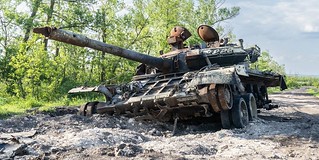The exchange of light weapons between soldiers from Spain and Poland in Latvia
NATO's Multinational Brigade in Latvia (formerly Battle Group Latvia) brings together personnel from 14 Allied countries.
This Brigade is the largest of NATO's multinational units in countries on the Alliance's eastern flank. Currently, there are units in Estonia, Latvia, Lithuania, Slovakia, Hungary, Poland, Romania and Bulgaria. The purpose of these units is to serve as a deterrent against the threat of Russian expansionism. Following Russia's annexation of Crimea in 2014, NATO launched this enhanced forward presence (eFP) operation in those countries in 2016. Spain is currently participating in the units deployed in Latvia (with armored units) and Slovakia (with light infantry and cavalry).

The Spanish contingent in Latvia since June is the eFP XIV, with the majority of its soldiers coming from the Brigade"Extremadura" XI, an armored unit based in Badajoz, which provides this mission with Leopardo 2E battle tanks, ASCOD Pizarro infantry fighting vehicles, M-113 VCZ sapper combat vehicles and M-109 self-propelled howitzers, among other vehicles.

The Polish Army Ground Forces has a company of PT-91 Twardy tanks in Latvia. Since December, the Polish unit deployed in Latvia belongs to the 19th Mechanized Brigade from Lublin. Like their Spanish colleagues from the "Extremadura" Brigade, the soldiers of this Polish Brigade have a black beret as their distinctive clothing. They are under the command of Major Marcin Wawro.

On August 12, at the Ādaži Military Base, NATO's Multinational Brigade in Latvia hosted the Allied Rifles exercise, which aims to improve the interoperability of contingents from different countries in the use of their small arms. The Brigade published the images of this exercise last Friday, some photos taken by Corporal Marc-André Leclerc of the Canadian Army, can be seen here.

In this series of photos we can see Spanish soldiers firing Polish FB Mini-Beryl assault rifles, the compact version of the FB Beryl assault rifle, which in turn was inspired by the Soviet Kalashnikov assault rifles. Introduced in 1997, the Mini-Beryl is chambered in 5.56×45mm NATO and weighs 3.4 kg without magazine. It has a rate of fire of 700 rounds per minute, with an effective range of 400 meters.

In this case we see the wz. 96B variant of the Mini-Beryl, introduced in 2004 and featuring Picatinny rails on the handguard for attaching accessories, in this case a red dot sight. This sub-rifle has a folding stock. Due to its small size, it is a very suitable weapon for tank crews.

Polish soldiers have also been able to test the Heckler & Koch G36E, the Spanish variant of the famous German assault rifle, introduced in 1996. It is also chambered in 5.56 × 45 mm NATO. It weighs 3.63 kg without a magazine. Its rate of fire is 750 rounds per minute, with an effective range of 600 metres. It has a folding stock that folds to the right of the receiver.

Like the Mini-Beryl, the G36E features a Picatinny rail, in this case on the handle. The G36Es in these photos have red dot sights on that rail. Personally, I am glad to see the good vibes between the two nations I hold most dear in the world.
|
Don't miss the news and content that interest you. Receive the free daily newsletter in your email: |
- Most read
- An excellent documentary shows the inside of the B-17 Flying Fortress bomber
- The new Frecce Tricolori planes and their new design, a work of Pininfarina
- The problems of the VH-92A Patriot, the new US Marine One presidential helicopter
- Ye Olde Pub: The American B-17 bomber saved by a German Bf-109 fighter pilot
- A high-quality short film of the French Air Force showing its capabilities
- The firearms used by the Pontifical Swiss Guard, the smallest army in the world
- The new CADPAT (MT) digital camouflage of the Canadian Armed Forces

 ES
ES







Opina sobre esta entrada: